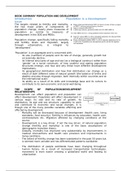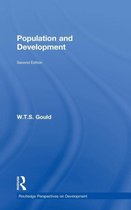BOOK SUMMARY POPULATION AND DEVELOPMENT
Introduction Population is a Development
Issue
The targets related to fertility and mortality,
the two major pillars of components of
population change, clearly place measures of
population as central to measures of
development in the SDG and MDGs.
Population change, specifcally falling mortality
and fertility levels and migration, largely
through urbanisation, is integral to
‘development’.
‘Population’ is an aggregate and is concerned with:
- its size (numbers of people) and its rate of change, generally growth but
occasionally decline;
- its internal structures of age and sex (as a biological construct rather than
‘gender’ as a social construct), of how youthful and ageing population
structures emerge, and how and why these have diferent development
implications;
- its geographical distribution and how that distribution can change as a
result of both diferent rates of natural growth (the balance of births and
deaths) and also through migration, both internally within countries and at
the international scale;
- its ability as a result of its skills and knowledge base and its culture to
contribute to its own economic and social well-being.
THE SCOPE OF POPULATION/DEVELOPMENT
RELATIONSHIPS
Development can afect population and population can
afect development. Population will afect development in
various ways: its size and its rate of growth, its
distribution, its age and sex structure, capability to work
and contribute to economic and social changes. It is
though one of the many possible variables afecting and
afected by development.
- Mortality will be decreased because of development (health care, living
standards, food security). Fertility is infuences by education, health care,
contraceptives etc. Migration afected by changing conditions at the
source.
- Development is a key driver, if not the key driver, of natural population
change (fertility and mortality) is one of the basic assumptions of
demographic transition theory.
- Globally, mortality has improved very substantially by improvements in
medical interventions and health care provision and improvements in
living conditions.
- The extent of fertility change has been substantial in the past 50 years but
is seemed more variable and has diferentiated patterns worldwide.
- The distribution of people worldwide have been changing throughout
human history. As a result of increased transportation technologies,
movement is even easier creating a globalized world and leading to
urbanization.
, - Rural–urban migration seems to be an inevitable consequence as well as a
cause of development.
Traditionally, Population Studies has been essentially quantitative, that is, about
population size, population distribution or age/sex structures.
- Development is more than about raising incomes – it must also be about
giving individuals the opportunity to make choices about their lives, based
on their skills, concerns and wishes.
- It is strongly associated with development planning by the state and
NGOs.
DEVELOPMENT STUDIES
Not only has the global political climate changed from the Cold War to emphasise
growing globalisation and new global power relationships, but there is a
widespread recognition of the relative failure of over 50 years of development in
many regions. Because the number of poor people worldwide is increasing a
more integrated approach is used nowadays not merely focussing on economic or
social sciences.
POPULATION STUDIES
William Godwin, who argued that unequal distribution of power in society was
the root cause of poverty. Malthus in reply argued that the poor were largely
responsible for their own poverty, and that population growth would in the long
run generate even greater poverty and inequality as the population would
outstrip the resources on which they could survive. Population Studies was given
a great boost after the Second World War through the UN with the formation of
its Population Division data they collected to similar specifcations were
internationally comparable. More important for Population Studies was the
turnaround in population growth rates between 1970-2000.
By the turn of the millennium the emphasis in global population change had
shifted again as rates of growth continued to fall – though remaining sufciently
high in some countries, especially in sub-Saharan Africa, to continue to be seen
as a threat to their development.
Chapter One Population and Development: The Core Issues in
Historical Perspective
The more people there are, the greater the resource base needs to be if average
consumption levels are to be sustained. This resource base is an economic
concern. Each additional person means that there will be more people to work to
create, manage and consume resources. Global levels of living have been rising
over many centuries, but most rapidly and more obviously during the last two
centuries.
- Life of hunters and gatherers: was short because of high mortality and were
just able to support themselves.
- Settle agriculture: leading to more controlled food available, increase in
productivity. But diseases, no technology and poverty and therefore low
population growth.
- Modern industrial societies: were highly specialized by technology,
movement of goods: rapid population growth and social and economic
development.
- Modern globalized societies: increase in the gap between rich and poor.
GLOBAL POPULATION CHANGE
, - Some of the declines were known to have
been spectacular, as in the bubonic
plague epidemic, the Black Death, of the
mid-fourteenth century. More recent HIV/
AIDS.
- During most of human history life
expectancies at birth were probably about
30–35 years. Mortality remained high
despite improved food security.
- Birth rates, on the other hand, were also
high, probably with an average of about
fve live births per woman over her
lifetime. Fertility was not subject to
similar rapid short-term fuctuations to
the extent that mortality could be.
- Normally mortality has fuctuated much more than fertility.
- As a result of the joint efects of diferential population growth and migration,
the global distribution of the human proportion has been constantly
changing.
o In the early years of human existence there was a constant
movement of people to all habitable areas around the world.
o By 1900, rapid population growth in Europe more than
compensated for the substantial emigration overseas but
population in Africa had fallen.
GLOBAL DEVELOPMENT
Human development is about people. It is about expanding people’s real choices
and the substantive freedoms – the capabilities – that enable them to lead lives
that they value. Choice and freedom in human development mean something
more than the absence of constraints. People whose lives are blighted by
poverty, ill-health or illiteracy are not in any meaningful sense free to lead the
lives that they value. Neither are people who are denied the civil and political
rights they need to infuence decisions that afect their lives.
Akin Mabogunje (1989), four interrelated meanings of development:
1. Development as Economic Growth: rising incomes and rising
production levels
2. Development as Modernisation: the change of the structures and
processes of economy and society, essentially consumer capitalism, that
have been associated with Western nations since the Industrial Revolution.
3. Development as Redistributive Justice: such that within any
population the gap between rich and poor narrows in the longer term. As a
result of political objectives and redistributive interventions by the state
(e.g. progressive taxation).
4. Development as Socio-economic Transformation: (written at the end
of the Cold War where socialist societies still thought in terms of a
transition from capitalism to socialism). Since then however the socialist
practice have been replaced by capitalism/neoliberal consensus (except
for China).
Would these have been written 20 years later than sustainable development
would have been included.
- The World Bank uses economic criteria (frst meaning) using GNP.






